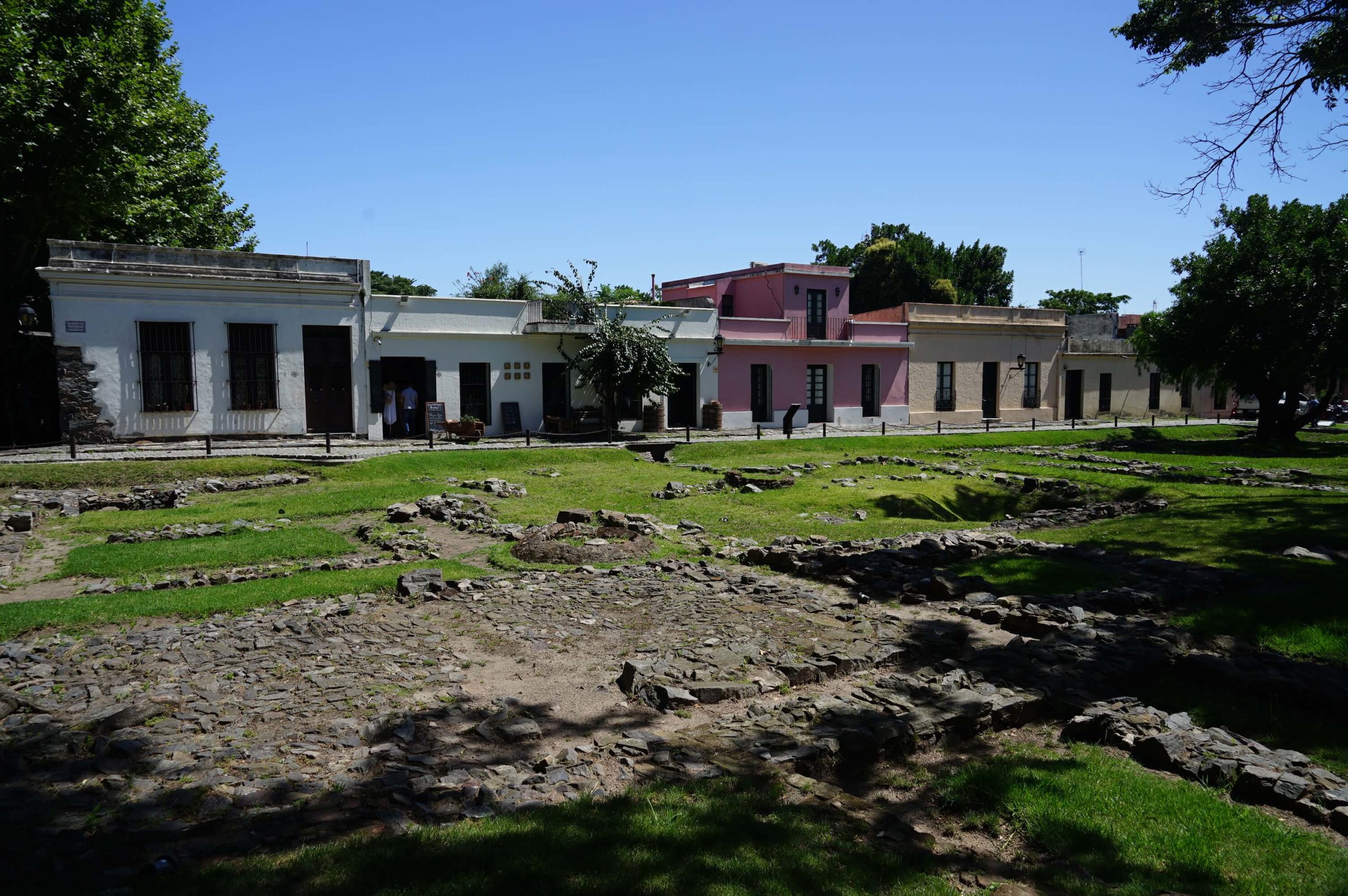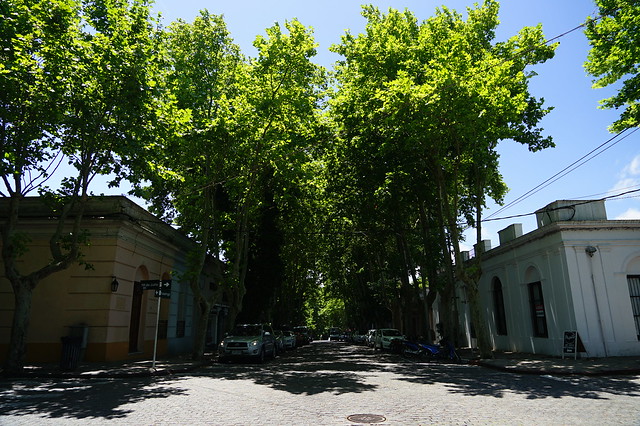Best preserved colonial city in Uruguay
One of the highlights of coming to Uruguay is taking the chance for visiting the oldest and best preserved colonial city in the country, the small Colonia del Sacramento right along the Rio de la Plata estuary and directly opposite Buenos Aires. You can see one each other from the shore. But before continuing, let me define a bit more what best preserved and oldest city means here: basically, do not expect a wonderful city like the ones you can see all over Central America, notorious example of glorious Antigua in Guatemala. Colonia is very small and lacks that opulence and flair. Take a remote, small and possibly unknown village in Spain or Portugal, and you have what you are about to visit here. Yes, it is a nice place, with a charm, but little more than that. In the other hand, expect lots of tourists from all over the world, it is the most visited place in the country.
Colonia was founded and developed by the Portuguese who had several posts along the Rio de la Plata, coexisting with the Spanish where several times conflicts and wars changed the hands to the Spanish and back to the Portuguese. Destruction and reconstruction until the early 18th century when after the Treaty of Utrecht it was handed back to Portugal who transformed it into the most wealthy and best defended city in the Rio de la Plata region. Fallen in the hands of Spain on several more occasion through the century, it can be said that it was never part of the Spanish Empire for longer than 20 years. Uruguay became an independent nation in 1828.
Considering as an average tourist you can fully explore in one day Montevideo, the country’s capital, then why not enjoy a day out here! Easy to come, bearing it’s 3 hours away by bus or car from Montevideo, or merely hour and a half from Buenos Aires by high speed boat and easy cross-country border formalities. What’s best, no need to scramble your head thinking what to do, what to see and how to plan a best route. Everything, everywhere is walking distance next to each other, plenty of restaurants, bars and cafes.
We spent around 6 hours in the city and was well more than enough, considering we did also enjoy a very slow-paced day compared to all the others in this tour the previous days. And to be honest I do not see any need for spending longer, unless continuing on a tour along northwest the Rio de la Plata towards what’s called the UNESCO Route. It links Colonia Valdense, Colonia del Sacramento, Colonia Estrella, Nueva Palmira, Dolores, Villa Soriano and Fray Bentos home to the stunning old complex of the Anglo meatpacking factory, inscribed as a World Heritage Site.
Along the main street that connects the historic quarter with the new town, crossing it from east to west, General Flores, you will find plenty of restaurants serving traditional food at good prices. Beware in any case that all this places are very touristy, but in general, do not worry on it. Colonia is very touristy hence everywhere you go it will be full. Likewise I mentioned in the Montevideo travel guide, something really authentic, national dish of Uruguay is a Chivito. A sandwich made of beef, bacon, ham, hard boiled or fried egg, olives, mozzarella, tomatoes, and mayonnaise, served with fries on the side. I would not hesitate in giving a try. Not only is delicious; it is fast and easy to eat and considering as a tourist you might be on a tight scheduled tour here, that’s possibly the best choice to have in mind.
For more information about Colonia visit Wikipedia and Wikitravel sites. Uruguay’s currency is the Peso ($U, UYU). Please note that any price reference is true as from when this guide was created, therefore check prices in advance as with the time they change.
What to see and do in Colonia
- Historic Quarter All of which listed by the UNESCO as a World Heritage Site. Located at the westernmost part of the city, with the Rio de la Plata surrounding it on three sides. It has an irregular urban plan legacy of the Portuguese, with a proper orthogonal grid of wider streets immediately east, legacy of the Spanish. You will see lots of colorful old houses, churches and bastions along the shore. The old city walls and main gate, small squares and even a pier. Impossible to get lost, but beautiful if you let yourself go without a route, merely wandering around.
Transports
Colonia does not have an airport, being the nearest one 200 kilometres away in Montevideo, Carrasco International Airport. It is the main gateway of the country to the world. While it is true there are not that many direct routes other than all over the Americas and some European destinations such as Madrid, it is definitely highly convenient considering how enormous distances can be in South America. It is located some 15 kilometres east of the city centre, and has a good bus connection towards different areas and districts. Most buses head past the main bus terminal Tres Cruces, along the Boulevard General Artigas, taking approximately 30 minutes and costing 56 UYU. Once there, buses between Montevideo and Colonia are very frequent through the day. The journey takes approximately 3 hours in each direction.
The ferry link between Colonia and Buenos Aires is the most popular way for travelling between both cities. From downtown to downtown is around hour and a half, the fastest way no doubt. There are other ports between these countries, hence other options to consider depending where is that you intend to go.
Once in Colonia, distances are minimal and good for walking everywhere. it’s a pity that there are no any pedestrian only streets within the historic area, and cars parked everywhere meaning it’s difficult to even get some nice photographs of the buildings. But if you hired a car, you can get anywhere you want with it and park at the very heart.
Accommodation
Because this was a day trip from our base in Montevideo, there is little to none I can suggest here. Yes it’s very small and yes this is a place where tourists come to spend the day and disappear later in the evening back to their bases. The choice of hotels is minimal, and perhaps is best to check for an apartment and guest houses.
If Montevideo is your base, it is the biggest showcase to the world, hence an important destination not only in tourism but in business too. It is also one of the most stable, secure and wealthy in South America, with a strong economy and currency; yet considering it is one of the smallest capitals of South America, the choice of hotels is just about right. Do not expect a wide selection nor competition, but a fair and good choice, though at a higher price than other countries in the continent. The best as usual, would be to start your search by checking some of our preferred affiliate hotel search engine such as Hotels.com, Booking.com, Expedia, Otel.com, Agoda, Opodo, LateRooms or Ebookers.
We found the best option for this trip to be the Radisson Victoria Plaza. At the very heart of the city in Independence Square, corner with Calle Florida. Spread across two towers, both offering nice views above the city and with great facilities such the very large indoor heated pool, jacuzzi, sauna and steam rooms; well designed large rooms, very comfortable and quiet as well, it was over our expectations. Very friendly and helpful staff in all departments, and a good breakfast. But overall, the location is unbeatable! Almost opposite the Palacio Salvo, one of the most important sights, and anything from culture, shopping, restaurants, bars and nightlife at walking distance.

